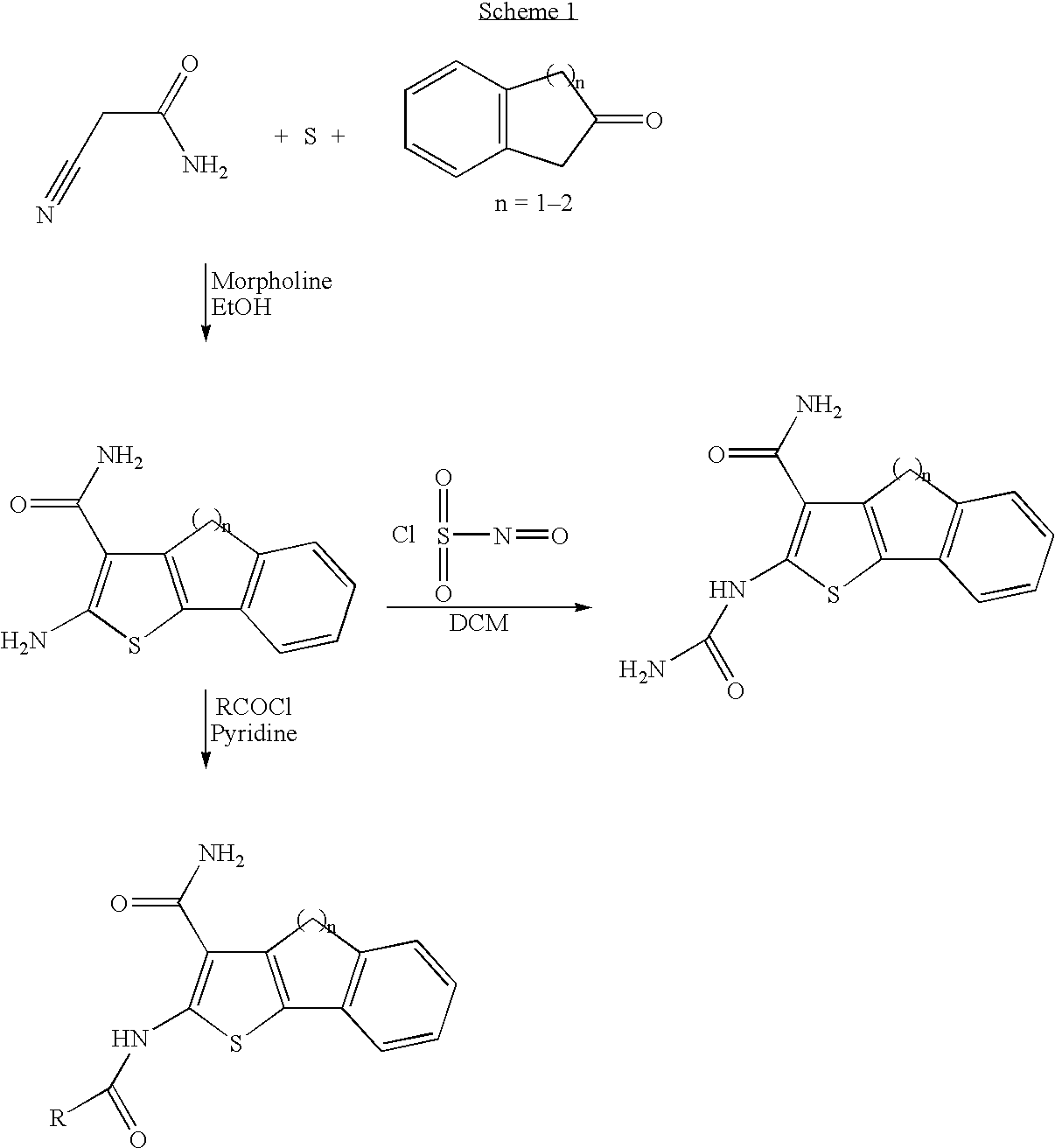NF-kappaB inhibitors
a technology of nf-kappab and inhibitors, which is applied in the field of nf-kappab inhibitors, can solve problems such as organ destruction
- Summary
- Abstract
- Description
- Claims
- Application Information
AI Technical Summary
Benefits of technology
Problems solved by technology
Method used
Image
Examples
examples and experimental
General
[0116]Nuclear magnetic resonance spectra were recorded at either 250, 300 or 400 MHz using, respectively, a Bruker AM 250, Bruker ARX 300 or Bruker AC 400 spectrometer. CDCl3 is deuteriochloroform, DMSO-d6 is hexadeuteriodimethylsulfoxide, and CD3OD is tetradeuteriomethanol. Chemical shifts are reported in parts per million (d) downfield from the internal standard tetramethylsilane. Abbreviations for NMR data are as follows: s=singlet, d=doublet, t=triplet, q=quartet, m=multiplet, dd=doublet of doublets, dt=doublet of triplets, app=apparent, br=broad. J indicates the NMR coupling constant measured in Hertz. Continuous wave infrared (IR) spectra were recorded on a Perkin-Elmer 683 infrared spectrometer, and Fourier transform infrared (FTIR) spectra were recorded on a Nicolet Impact 400 D infrared spectrometer. IR and FTIR spectra were recorded in transmission mode, and band positions are reported in inverse wavenumbers (cm−1). Mass spectra were taken on either VG 70 FE, PE Syx...
example 1
2-Amino-4H-indeno[1,2-b]thiophene-3-carboxylic acid amide trifluoroacetate
[0121]Morpholine (1 mL) was added dropwise to a stirred solution of cyanoacetamide (0.84 g, 0.01 mol), sulfur (0.36, 0.012 mol), and 2-indanone (1.32 g, 0.01 mmol) in absolute ethanol (5 mL). The resulting solution was stirred at 60° C. overnight. The solvent was then removed under vacuo and the residue was taken up into ethyl acetate (10 mL), washed by water (2×10 mL) and brine (10 mL), dried over anhydrous magesium sulfate, filtered and concentrated under vacuo to give a dark brown solid. The product was then purified on Gilson preparative HPLC (YMC HPLC column 50×20 mm I.D., s-5 μm, 120 Å; gradient elution, 0.1% TFA in acetonitrile:0.1% aqueous TFA, 10:90 to 90:10, 10 min) to give the title compound as a brown solid (100 mg, 0.435 mmol, 4.3% yield). ESMS m / z: 231 [M+H]+.
example 2
2-Ureido-4H-indeno[1,2-b]thiophene-3-carboxylic acid amide
[0122]Chlorosulfonyl isocyanate (0.025 g, 0.17 mL) was added dropwise to a stirred solution of 2-amino-4H-indeno[1,2-b]thiophene-3-carboxylic acid amide trifluoroacetate (0.040 g, 0.17 mmol) in dry dichloromethane (2 mL). The resulting reaction mixture was stirred under nitrogen for 30 min. Water (0.5 mL) was then added to the reaction mixture and the reaction mixture was allowed to stir an additional 10 minutes before the solvent was removed under vacuo. The residue was then purified on Gilson preparative HPLC (YMC HPLC column 50×20 mm I.D., s-5 μm, 120 A; gradient elution, 0.1% TFA in acetonitrile: 0.1% aqueous TFA, 10:90 to 90:10, 10 min) to give title compound as brown solid (0.020 g, 0.435 mmol, 43.5% yield). ESMS m / z: 274 [M+H]+.
PUM
| Property | Measurement | Unit |
|---|---|---|
| temperature | aaaaa | aaaaa |
| mass median diameter | aaaaa | aaaaa |
| mass median diameter | aaaaa | aaaaa |
Abstract
Description
Claims
Application Information
 Login to View More
Login to View More - R&D
- Intellectual Property
- Life Sciences
- Materials
- Tech Scout
- Unparalleled Data Quality
- Higher Quality Content
- 60% Fewer Hallucinations
Browse by: Latest US Patents, China's latest patents, Technical Efficacy Thesaurus, Application Domain, Technology Topic, Popular Technical Reports.
© 2025 PatSnap. All rights reserved.Legal|Privacy policy|Modern Slavery Act Transparency Statement|Sitemap|About US| Contact US: help@patsnap.com



